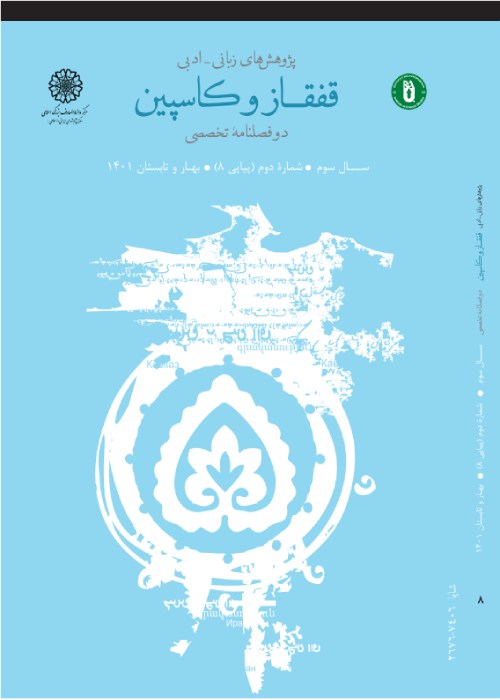فهرست مطالب
نشریه پژوهش های زبانی - ادبی قفقاز و کاسپین
پیاپی 2 (پاییز 1398)
- تاریخ انتشار: 1398/09/01
- تعداد عناوین: 6
-
صفحات 27-61
-
صفحات 63-71
-
صفحات 73-88
-
صفحات 89-97
-
Pages 1-6
This paper presents the occurrences of the ethnonym Čiłb in Armenian historiography. The Armenian medieval sources give sufficient information for the localization of the ethnic group known under this name – the southern parts of the Caucasian mountains near the city of Shemakhi in nowadays Republic of Azerbaijan. The Armenian authors witness the Chilbs as a mountainous, semi-nomadic and warlike people. The origin of the ethnonym Čiłb is not clear but its possible connection with the toponym Shirvan must not be fully discarded.
Keywords: Armenian Historiography, Ethnonym Čiłb (Chilb), CaucasianAlbania -
Pages 7-25
In this preliminary study, the relation between Behdinan dialect as an instance of Iranian languages- despite limited texts- and the old texts of some Iranian languages has been reviewed. The aim of this study is to shed light on the historical similarities between Behdinan dialect and these languages. According to this preliminary study, the similarity between Behdinan dialect and the old texts on Median language Aδarbāygān's Old Language is more evident than the similarity between Behdinan dialect and Dari Persian.
Keywords: Behdinan Dialect, Median Language, Aδarbāygān's OldLanguage, Dari Persian -
Pages 27-61
The Gurani language belongs to the group of modern northwestern Iranian languages. This language has been used in post-Islamic Iran as the standard literary language of western Iran and many literary works have remained in this language since the 3 rd century AH. This language was being formed in the Achaemenes era and covered a much wider area than today. One of the words in the lexicon of this language is gâwdam دمگاو/gâw-dum مگاود) the name of two weapons) which has reached Eastern Iran (gâw-dam in Šāhnāmeh) and China (jâ-dam in Silsilat alTawārīx) in two branches. After describing and introducing the Gurani language and literature, and looking at the association of this language with gâw and its related myths, this article examines the uses of the word gâw-dam دمگاو and its overlapping words in Gurani, Persian, and Chinese languages.
Keywords: Guran, Gurani, Gâw-dam, Gâw-dum, Jādam, Gāvsar -
Pages 63-71
Due to the significance of vowels in the acoustics of languages, the present study is designed to investigate the simple and complex vowels in Kermanshahi Kurdish in terms of first and second formants (F1 and F2). Vowels in CVC and CV syllables of Kermanshahi Kurdish words are selected in word reading speech and the differences of formant frequency in open and closed syllables are investigated. In order to evaluate and determine the transgender formant frequency, 10 Kermanshahi Kurdish speakers (5 males and 5 females) are selected. Based on the results obtained from our analysis using Praat software, there are 8 simple vowels in Kermanshahi Kurdish including (a, e, o, ɑ, ı, u, i, and y) and 8 complex vowels (ɑe, ei, eo, ya, yɑ, ia, iɑ and ey).
Keywords: Kermanshahi Kurdish, Acoustics, Simple Vowel, ComplexVowel, Vowel Formant Structure -
Pages 73-88
Tabarestan and the southern Caspian Sea have always been of great importance to geographers and historians. Pahlavi texts have also referred to this area and its various toponyms a lot. In this article, Tabarestan regions are identified and located in the most important Pahlavi texts such as Patešxwārgar, Tabarestān, Āmol, Damāwand, and Gorgān. This article also addresses Avestan toponyms in Pahlavi texts such as Alborz and Mazandarān which later have been relocated to Tabarestan. Such studies will shed light on the image of the historical geography of Tabarestan and the southern Caspian Sea in Sassanian texts; as a result, they will contribute to the understanding of the historical geography of Islamic texts.
Keywords: Historical Geography, Sasanians, Tabarestan, Caspian Sea, Pahlavi texts -
Pages 89-97
In Neẓāmī's Xosrow o Šīrīn when Xosrow leaves Šīrīn in Muγān (Muqān) and departs to Constantinople, the poet refers to a toponym named gylk/gwn, which has not yet a reliable interpretation. It seems that گیلگون/گیلکون in the Neẓāmi's poem should be identified with Gełakʿuni, a region in the Lake Sevan basin. The present paper is an attempt to identify the place-name گیلگون/گیلکون in the text of Neẓāmīʼs Xosrow o Šīrīn.
Keywords: Neẓāmīʼs Xosrow o Šīrīn, Gēlakūn, Gełakʿuni, Armenia


